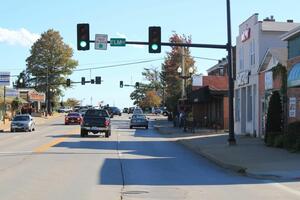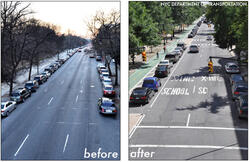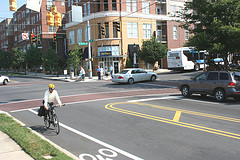UNBELIEVABLE: St. Charles County tries to prevent O'Fallon from upgrading its own Main Street
Recently, the city of O'Fallon decided to take some major steps to upgrade its main street--making it friendlier for walking, bicycling, businesses, visitors, and motorists via a so-called "Road Diet". Things got ugly when St. Charles County stepped in with a $2.5 million threat if the city implements the project. Now St Louis regional advocacy group Trailnet is stepping up now to defend better communities for walking & biking.

An unbelievable scenerio, as a county pressures a city to take a big step backwards
This is, frankly, one of the most unbelievable scenarios we have seen in many years of advocacy for better communities for walking and bicycling. The city, which is close to the situation and knows its own needs, had gone through a detailed planning process for improving its main street. The process included public meetings, interviews, and many other forms of public outreach to find out what O'Fallon citizens and businesses really want and need from the project.
After all of that, the County--without doing any similar research or public outreach--stepped in and, attempting to exercise bald political power, issued a threat: If the city goes through with its citizen-supported plan, the County will withhold $2.5 million in funding from the city.
This is not the first time St. Charles County has used a similar a threat to derail a city's work to make its city center more walkable and bicycleable. St. Charles County recently pressured the City of St. Charles to remove planned bike lanes from a project.
It is unfortunate that St. Charles County is taking these steps backward at this important time. Because cities around Missouri, around the United States, and around the world are increasing taking dramatic steps to improve their city centers for bicycling and walking.
And this is not just an issue about who is going to prevail in a political tug of war. The reason advocates and community members are so passionate about implementing road diets in the streets that run through the hearts of their communities is that road diets save lives.
At the cost of (at most) a few seconds delay in travel, many severe injuries and deaths are prevented. Why are elected officials in St. Charles County prioritizing a few seconds travel time over saving severe injury and death of the citizens they are elected to represent and to protect?
We are at a point now where citizens in O'Fallon and St Charles County can stand up an make a difference. St. Louis regional advocacy group Trailnet is leading the charge.
O'Fallon makes a plan to improve its old, outdated, ugly Main Street
The letter Trailnet sent to St Charles County has details about O'Fallon's plan to improve its Main Street: 
Earlier this year, as part of a planning study for the Highway K, Main St. and Highway M corridor, the City of O'Fallon did something important: it asked residents to help develop a vision for a revitalized downtown Main Street.
In a series of focus group meetings, surveys, individual interviews and public workshops the people of O'Fallon spoke loud and clear. More than half believe the four-lane Main Street thoroughfare is declining; 82% said they do not take visitors there. Words commonly used by participants to describe Main Street included "old," "outdated" and "ugly." They said Main Street needs a greater variety of businesses to draw residents and visitors; that the streetscape, aesthetics, functionality and walkability of Main Street all need to be improved.
Increasingly local governments in this region and around the country are hearing what O'Fallon heard from its residents: the public desires better main streets with balanced traffic flows, improved aesthetics, and new businesses that attract more customers and provide a great destination.
St. Charles County makes a power play to stop Main Street improvements
Fox 2 News tells what happened after the city started moving forward with its plan to improve walkability and calm traffic in the city center. Local business owner Joe Cronin is on the St. Charles County Council:

[L]ast week, Cronin convinced the County Council to give O`Fallon an ultimatum; pass a resolution promising to abandon the proposed road diet, or face losing county money for two other city road projects.
O'Fallon city officials are not too pleased about this turn of events:
O`Fallon Councilman Jim Pepper finds the county`s threat outrageous. . . .
The county is giving O`Fallon until November to pass a resolution promising not to put Main Street on a road diet, or else.
'I think that`s bullying at its highest,' said Pepper.
What O'Fallon was doing to improve its Main Street--and why communities around Missouri and the U.S. are doing the same
O'Fallon citizens wanted to improve Main Street, making it more accessible, more usable, and more valuable for citizens, business, local neighborhoods, and the community.

They want to make a Main Street that is a destination, not just a thoroughfare.
And they wanted to prevent the many injuries and deaths that are inevitable when fast-moving traffic is moving through populated city centers. These injuries and deaths affect everyone, but they disproportionately strike the vulnerable in our population: Children, the elderly, people with disabilities, pedestrians.
And they are completely preventable.
Projects designed to address these serious issues head-on are often called "road diets," because they take wide expanses of unecessary road space, reserved for fast-moving motor vehicle traffic, and change it, making the entire streetscape more inviting, pleasant, and safe for the people and businesses who use the area.
At the same time, a well-designed road diet actually improves safety and traffic flow for motorists as well. The road diet is one of the few types of road treatments that actually improve the experience for all road users, including people who drive, walk, bicycle, and use transit.
Since downtown is a place people come to visit and shop, it is very much in the interest of business owners to improve the pedestrian experience in the area.
At the same time, businesses want to encourage drive-by traffic and hate to divert traffic from flowing through the area. The good news for them is that a well designed road diet--including optimal design of turns lanes and traffic signals--can carry all the traffic the previous ill-designed four-lane road can. A road diet actually improves business along the corridor, because the area becomes an inviting destination that attracts visitors to come downtown and stay there once they have arrived. And yet, the road can still carry all needed motor vehicle traffic.
Communities who have implemented road diets have found that they do all of these things--improve traffic safety, carry the needed traffic flow, and greatly improve the experience for residents who visit and shop in the area.
The end result is a Main Street that is far more attractive to residents and visitors, and far more valuable to the city and to businesses in the area.
Road diets work across the country and in Missouri
Kansas City, Missouri, recently identified 130 streets that are candidates for road diets, and is working to implement the highest priority candidates.
St. Louis, Missouri, recently implemented road diets on no less than 10 city streets as part of its extensive Bike St. Louis Phase III, and results so far are excellent--an improved experience for motorists, pedestrians, and cyclists.
The video above, showing a planned road diet in the city of Camden, South Carolina, gives a good idea of what the O'Fallon road diet would look like. It is a complete upgrade in every aspect of the road--the sort of main street every city wants.
Road diets work and work well. O'Fallon businesses and citizens should support them, and so should St. Charles County.
Road diets--what are the benefits?
The Federal Highway Administration studied road diets and found these benefits for communities that implement them:

- An overall crash reduction of 19 to 47 percent.
- Reduction of rear-end and left-turn crashes through the use of a dedicated left-turn lane.
- Fewer lanes for pedestrians to cross and an opportunity to install pedestrian refuge islands.
- The opportunity to install bicycle lanes when the cross-section width is reallocated.
- Reduced right-angle crashes as side street motorists must cross only three lanes of traffic instead of four.
- Traffic calming and reduced speed differential, which can decrease the number of crashes and reduce the severity of crashes if they occur.
- The opportunity to allocate the “leftover” roadway width for other purposes, such as on-street parking or transit stops.
- Encouraging a more community-focused, “Complete Streets” environment.
- Simplifying road scanning and gap selection for motorists (especially older and younger drivers) making left turns from or onto the mainline.
Why leaders shouldn't delay in implementing road diets: Lives hang in the balance; Benefits far outweigh costs
City leaders in New Brunswick, New Jersey were recently facing a decision similar to the one that currently faces St. Charles County and O'Fallon officials. Citizens proposed a road diet to improve safety and save lives, but city leaders balked, hesitant to slow traffic flow by even a minor amount.
The Atlantic outlines what happened next:
In May 2014, three school kids in New Brunswick, New Jersey, were hit by a car on Livingston Avenue while in the crosswalk. They were each injured—one seriously—and rushed to the hospital. A cell phone video taken at the scene is pierced with anonymous screams.
Fortunately, according to news reports, the kids recovered. Unfortunately, the trauma they and their families endured is all too common on the streets of U.S. cities. What makes the situation in New Brunswick so much more regrettable is that city leaders knew about the safety hazards on Livingston Avenue but hesitated to change traffic patterns for fear of offending drivers.
That’s the frustrating conclusion one gets from a new case study about implementing a road diet on Livingston. The analysis finds that the safety benefits of reducing automobile space and speeds on the street would far outweigh any losses from driver delay. But the report’s authors state that officials were concerned from the start about upsetting the car-centric status quo.
After this devastating incident, public outcry led the city to commission a report to determine the full cost and benefit of implementing the road diet. The report concluded:
Our results have shown that implementation of a road diet, consistent with a complete streets policy along Livingston Avenue will result in some extra delay to traffic both along and within the corridor. However, the costs of the delay to traffic are less than the large benefits associated with the reduction in traffic crashes, based on a cost/benefit analysis.
In fact, the report found that the benefits of the road diet--improved mobility, reduction of injury and fatality--massively outweight the cost--which amount to a few seconds travel delay. Using standard measures of the cost of time and the cost of injuries and fatalities, the report found the net benefit of the road diet ranges between $2.6 million and $37 million over a twenty year period.
So it's not even a close call.
What you can do
- Wherever you live: Help us spread the word about this unfortunate county power play in social media.
- If you live in the St. Louis area: Please support Trailnet, your local bicycle and pedestrian advocacy group. They are leading the work to improve bicycling and walking across the region.
- If you live in St. Charles County: Contact your St. Charles County Council member and politely and persuasively let them know that you strongly support the work of cities like O'Fallon and St. Charles to improve the walkability and bikewability of their cities, you support the O'Fallon road diet proposal, and you oppose the County's interference in the local decision-making and local priorities of these cities.
- If you live in O'Fallon or St. Charles: Contact your city council member (O'Fallon - St Charles) and mayor and let them know that you support making the city better for walking and bicycling, you support the O'Fallon Main Street road diet proposal, and you hope they will work to oppose the County's interference in local affairs and decision-making.
The simplest way to help if you live in St. Charles County and/or the cities of O'Fallon and St. Charles, is to send your elected representatives a copy of Trailnet's letter about this situation, and include a note telling your elected officials that you support the points outlined in the letter.
More information:
- Trailnet's letter supporting the O'Fallon Main Street proposal
- All the technical details about road diets, traffic studies, and information on how road diets can carry traffic flow while greatly improving walkability along the corridor and increasing property values all along the street
- Road Diets: What they are and why they are good for your community - BikeWalkKC
- FHWA report on road diets
- MoBikeFed's Complete Street information center
Among the top goals of MoBikeFed's Vision for Bicycling and Walking in Missouri are improving safety for all road users in Missouri and creating a world-class bicycle and pedestrian network. Projects like the O'Fallon road diet help accomplish both of those objectives.
Your ongoing membership and generous financial contributions help keep the Missouri Bicycle & Pedestrian Federation healthy so that we can continue to pursue our statewide bicycle and pedestrian advocacy goals and turn our Vision into reality.
Image Credits
- Main Street: City of O'Fallon, Main Street planning handout
- Joe Cronin: St. Louis County Council
- Complete Street: National Complete Streets Coalition
Join MoBikeFed's Advocacy Network
Working together we make a real difference! Join our advocacy network:
Related pages
Current topics...
Archives...
Want better bicycling and walking in Missouri?
We rely on the support of members like you. Please join, renew, or donate today.
- Home
- JOIN/DONATE
- News/Info
- Missouri Bicycling, Running, Trails
- Bicycle Skills and Safety
- Missouri Bike/Ped Law
- Clubs and Organizations
- Bike Shops
- Running Shops
- Bicycling, Running, Trails-related Businesses
- Ride, Run, Walk, Hike, Triathlon, and Events Calendars
- Bicycles on Amtrak
- Maps and Routes
- Trails and Trail Maps
- IBikeMO.org
- Planning a Missouri bicycle trip
- Gravel and Bikepacking Maps & Routes
- Bicycle & Touring Routes
- Advocacy
- Campaigns
- Our Legislative Platform
- Complete Streets
- Statewide Rock Island Trail
- Statewide Trail Vision - Quad State Trail
- Bicycle Friendly Missouri
- Walk Friendly Missouri
- Safe Routes to School
- MoDOT funding crisis
- High Priority Bike/Ped Project List
- Anti-harassment laws in cities & statewide
- Updating the basic bicycle law
- Our Vision for MoDOT
- Our Vision for MPOs/RPCs
- Our Vision for Cities & Counties
- Bicycle, pedestrian, trails plans across MO
- Protecting Vulnerable Road Users
- Vision Zero
- Missouri Trail Towns
- Store
- About

